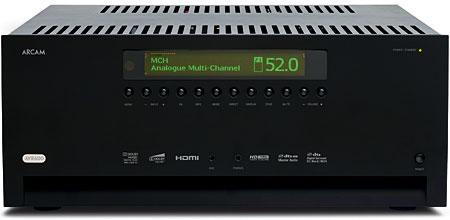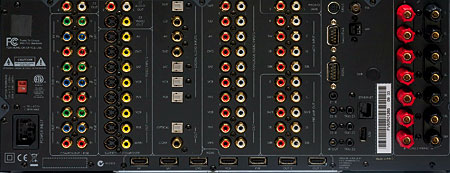Arcam AVR600 A/V Receiver

From Our Audiophile Wing
When you hear the phrase high-end home theater, what’s the first thing you think of? If you’re into home design, your mind might summon up a lavishly appointed screening room with a curtained screen, seating, and a popcorn machine. For you, it’s the wine bottle that’s high end, not necessarily the wine.
If you’re into the nuts and bolts of multichannel audio—the wine this time, not the bottle—you’ll be dreaming of fabulously powerful separates. Odds are you won’t think of an A/V receiver, despite the fact that a product like the Arcam AVR600 has a genuine high-end pedigree. A high-end British pedigree, no less.
There are always those folks who assert that the words high end and home theater don’t belong in the same sentence unless the sentence is, “There is no such thing as a high-end home theater.” Some of these folks are fascinated by $1,800 power cables. But home theater does indeed have an audiophile wing. And there are people who may be willing to invest $4,995 in a receiver that handles movies like a steroidal bar bouncer and music like a tuxedoed connoisseur. Those are the people who I address now.
Charcoal Gray, No Pinstripes
The AVR600 is not quite a black box—it’s more dark charcoal gray. Utterly innocent of knobs, it has a big bright-green display, with a dozen small buttons below it, including two for volume up and down. Good luck finding them in the dark. The input labels sound notes of both nostalgia (VCR) and trendiness (iPod). The power button is either on or hard-off, but you can go from standby to on by pressing any button on the front panel. The only front-panel connections are two mini-jacks, headphone, and auxiliary line in. At the bottom is a ventilation slot that the receiver uses for either convection or fan cooling, depending on its mood. The no-frills ethos carries through to the remote, which almost makes a fetish of it. The remote’s volume buttons are small, the same size and shape as all the other buttons, and well hidden in the layout. In a custom-install scenario, you may opt for a touchscreen remote, or at least a fancier one. But then again, you may not.

The back panel is very well organized in columns and includes five HDMI inputs and two outputs. It also has a large component video complement, with five inputs and one output. You could theoretically feed three displays with 10 high-def signal sources. Other noteworthy citizens of the connectivity village include a moving-magnet phono input, the obligatory iPod dock input, and 7.1-channel analog inputs and outputs. These are important options in a product that may someday extend its usefulness by serving as a surround processor or, more likely, a seven-channel amp. The pre-outs include three subwoofer outputs, a new high in my experience. “The more, the merrier,” an Arcam spokesperson said, noting that the company’s reference theater in Cambridge (U.K.) uses four subs. You can connect the network input to a router for Internet radio and PC playback. It’s thrilling to find a UPnP-compliant USB input that’s compatble with FLAC, Ogg, WMA, AAC, and MP3 files. One suggestion to Arcam: Move it to the front.
When the receiver powers up, it displays a brief status stripe at the bottom of the screen. If you penetrate the onscreen menus, you’ll find a text-based menu that’s not so much monochrome as black and white and blue and gray. Although it includes an auto-setup mode—which is absent from some other small-brand audiophile receivers—Arcam also makes it easy to manually adjust the speaker type, distance, and level by placing those parameters in the menu’s top level. The basic Dolby and DTS listening modes (DPLII, Neo:6) may be individually switched on or off. So if you’re sure you’ll want DPLII Movie and Music but not the Game or other modes, you can switch the former on and the latter off. Then you won’t have to cycle through the unwanted modes later.
Arcam’s auto setup and room correction are proprietary. The company’s institutional position on room equalization bears quoting: “By default, room EQ is not applied to any of the source inputs. You should enable room EQ on inputs you think benefit from this feature, as required, by listening when playing typical source material through each input. While room equalization can help to reduce problems with listening-room acoustics, it is usually far better to try to solve these problems with the room directly. Proper loudspeaker positioning, acoustic wall treatments, and moving the listening position away from the walls should produce far better results overall. However, it may be difficult to do this in a home environment, so room EQ is your next best choice.”
This is advice worthy of an audiophile receiver manufacturer. Speaker and seat positioning are your meat and potatoes. Room EQ is gravy. Taste your food before you add the gravy. It’s better to eat fresh food than to smother rotten food with gravy.
One of the most heartening recent developments in surround is the availability of sophisticated modes for low-volume listening. The one Arcam has chosen to license is Dolby Volume. This receiver applies Dolby Volume separately to each input. Dolby Volume has two basic functions, leveling and modeling.
Leveling evens out the volume levels within content and among content sources. That makes some content (like ad-supported TV or loud action movies) easier to take. It also reduces the need for master volume adjustments when you change inputs. The modeling function compensates for the ear’s natural tendency to alter frequency perception at different volume levels.
The AVR600 has two user-adjustable Dolby Volume parameters. The default Leveling setting is 9 on a scale of 0 to 10—in other words, they want you to readily hear the effect at first, but they give you a lot of range to turn it down as needed. It also includes a calibration offset that adjusts the reference volume up or down, independently of the normal speaker setup menus, “to compensate for speaker efficiencies and listening position,” says the manual. The default setting is zero, or neutral, which maintains the reference level you presumably were careful enough to calibrate with an SPL meter at Arcam’s recommended 75 decibels when you manually set up the receiver. If you want to change the master level for each input (especially as it relates to how it is affected by Dolby Volume), here’s your chance.






























































